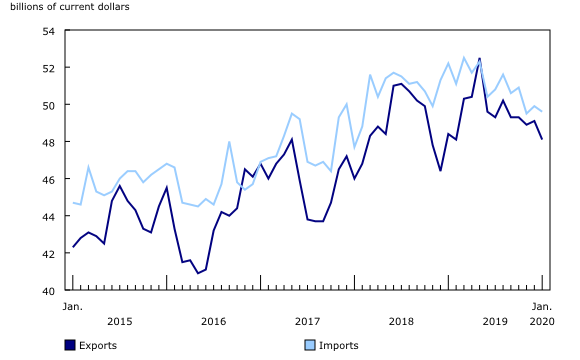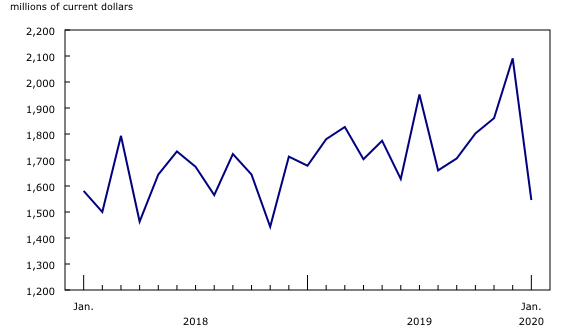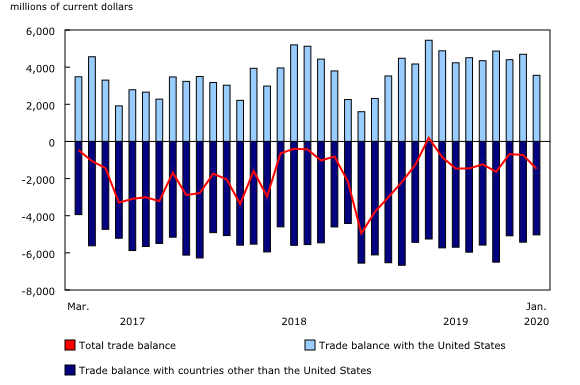Canadian international merchandise trade, January 2020
Archived Content
Information identified as archived is provided for reference, research or recordkeeping purposes. It is not subject to the Government of Canada Web Standards and has not been altered or updated since it was archived. Please "contact us" to request a format other than those available.
Released: 2020-03-06
Canada's merchandise exports fell 2.0% in January, in part due to lower exports of motor vehicles, while imports were down 0.5% mostly on lower imports of pharmaceutical products. As a result, Canada's merchandise trade deficit with the world widened from $732 million in December 2019 to $1.5 billion in January.
Exports of motor vehicles decrease
Total exports fell 2.0% in January to $48.1 billion, with 9 of 11 product sections posting declines. In real (or volume) terms, exports were down 3.1%.
Exports of motor vehicles and parts registered the largest decline in January, down 4.1% to $7.3 billion, the lowest level since May 2018. This was primarily the result of lower exports of passenger cars and light trucks (-8.2%), reflecting longer temporary shutdowns at certain assembly plants, as well as the recent closure of the General Motors plant in Oshawa. For the same reasons, imports of motor vehicle engines and parts (-7.1%) were also down substantially in January.
Exports of energy products were down 1.7% in January, mainly on decreased exports of natural gas (-26.2%). Temperatures across much of the United States were above typical January levels, resulting in lower demand for natural gas and thus a decrease in export volumes as well as prices. Exports of coal (-23.6%) also fell in January, notably on lower exports to Japan.
Imports of pharmaceutical products decline
Total imports were down 0.5% in January to $49.6 billion. After surpassing the $50.0 billion level for most months in 2018 and 2019, total imports have been below this threshold for the past three months. Year over year, total imports fell 4.9% compared with January 2019, the strongest year-over-year decline in more than 10 years. In real (or volume) terms, imports (-0.5%) also decreased in January.
Imports of consumer goods posted the largest decline, falling 6.3% on lower imports of pharmaceutical products (-26.1%). The decrease in imports of pharmaceutical products follows four consecutive months of growth, over which they rose 26.0%. Most of the monthly decrease in January was due to imports of antiviral and cancer treatment drugs.
Imports of metal ores and non-metallic minerals rose significantly in January, up 41.9%. Following a 29.5% decline in December 2019, imports of other metal ores and concentrates rose 55.7% in January, mainly on higher imports of gold for refining purposes. Higher gold prices played a significant role in the increase.
Imports of energy products rose 7.6% in January on higher imports of crude oil (+26.4%), which reached the $2.0 billion mark for the first time since 2014. Higher imports of crude oil from the United States to Eastern Canadian refineries coincided with production disruptions on the Canadian North Atlantic oil platforms.
Exports to the United States decrease
Exports to the United States fell 1.7% in January, mainly due to passenger cars and light trucks. Imports from the United States were up 1.6%, the first increase in five months.
As a result, Canada's trade surplus with the United States narrowed from $4.7 billion in December 2019 to $3.6 billion in January, the smallest surplus since February 2019.
Imports from countries other than the United States fell 4.1% in January, led by lower imports from Belgium (parts of other transportation equipment) and China (cellphones).
Exports to countries other than the United States declined 2.8% in January. There were lower exports to European countries (mainly Italy, Germany and Belgium) as well as to China. Higher exports of gold to the United Kingdom and Hong Kong partially offset the decrease.
Canada's trade deficit with countries other than the United States narrowed from $5.4 billion in December 2019 to $5.0 billion in January, the lowest deficit in more than a year.
Impacts of coronavirus on merchandise trade
Statistics Canada is monitoring possible impacts of the coronavirus on Canada's international merchandise trade data, particularly with China. Due to the recent slowing of Chinese economic activity, and efforts in many countries to contain the spread of the virus, the effects of the outbreak could be more deeply felt in subsequent months.
Canada's merchandise trade with China in January 2020
In January, substantial decreases in exports and imports with China were observed, which coincided with the intensification of the coronavirus outbreak at the end of the month.
Exports to China followed a downward trend in the second half of 2019, settling at the lowest level for a six-month period since the first half of 2016. In January 2020, monthly exports to China decreased 7.8%, with lower exports of gold, potash and wood pulp contributing to the drop. On a year-over-year basis, January exports to China were down 8.6%.
Meanwhile, imports from China fell 12.1% to $3.4 billion in January, the lowest level in three years. Imports of communication and audio and video equipment (mainly cellphones) showed the largest decline.
China is Canada's second largest trading partner after the United States
On a balance of payments basis, Canada imports about twice as much from China as it exports. In 2019, imports from China totalled $46.8 billion, and exports to China settled at $24.4 billion. China was Canada's second largest trading partner for both imports and exports in 2019.
The top imported products from China in 2019 were communication, and audio and video equipment; computers and computer peripherals; clothing, footwear and accessories; as well as miscellaneous goods and supplies. The top exported products to China in 2019 were pulp and paper; passenger cars and light trucks; and iron ores.
Indirect impacts of the coronavirus
This situation could also create indirect effects that influence Canada's merchandise trade statistics. Commodity prices, for example, could fluctuate and contribute to changes to Canada's export and import values.
The impact could also be observed beyond the bilateral trade relationship between Canada and China. With numerous countries now affected by the virus, efforts to contain its spread may have an impact on their trade activities. Additionally, because China is one of the largest manufacturers in the world, other countries may experience a slowdown in their trade activity with Canada as a result of dependencies on Chinese inputs.
Revisions to December 2019 merchandise exports and imports
Imports in December, originally reported as $49.7 billion in the previous release, were revised to $49.9 billion in the current month's release. Exports in December, originally reported as $49.3 billion in the previous release, were revised to $49.1 billion.
Monthly trade in services
Monthly exports of services fell 1.1% in January to $11.1 billion. Imports of services declined 2.4% to $12.7 billion.
Combining international trade in goods and services, exports were down 1.8% in January to $59.2 billion, while imports decreased 0.9% to $62.3 billion. As a result, Canada's trade deficit with the world for goods and services combined was $3.1 billion in January.
Note to readers
Merchandise trade is one component of Canada's international balance of payments (BOP), which also includes trade in services, investment income, current transfers, and capital and financial flows.
International trade data by commodity are available on both a BOP and a customs basis. International trade data by country are available on a customs basis for all countries and on a BOP basis for Canada's 27 principal trading partners (PTPs). The list of PTPs is based on their annual share of total merchandise trade—imports and exports—with Canada in 2012. BOP data are derived from customs data by making adjustments for factors such as valuation, coverage, timing and residency. These adjustments are made to conform to the concepts and definitions of the Canadian System of National Accounts.
For a conceptual analysis of BOP versus customs-based data, see "Balance of Payments trade in goods at Statistics Canada: Expanding geographic detail to 27 principal trading partners."
For more information on these and other macroeconomic concepts, see the Methodological Guide: Canadian System of Macroeconomic Accounts (13-607-X) and the User Guide: Canadian System of Macroeconomic Accounts (13-606-G).
Data in this release are on a BOP basis and are seasonally adjusted. Unless otherwise stated, values are expressed in nominal terms, or current dollars. References to prices are based on aggregate Paasche (current-weighted) price indexes (2012=100). Volumes, or constant dollars, are calculated using the Laspeyres formula (2012=100).
For information on seasonal adjustment, see "Seasonally adjusted data – Frequently asked questions."
Revisions
In general, merchandise trade data are revised on an ongoing basis for each month of the current year. Current-year revisions are reflected in both the customs and BOP-based data.
The previous year's customs-based data are revised with the release of the January and February reference months, and thereafter on a quarterly basis. The previous two years of customs-based data are revised annually, and revisions are released in February with the December reference month.
The previous year's BOP-based data are revised with the release of data for the January, February, March and April reference months. To remain consistent with the Canadian System of Macroeconomic Accounts, revisions to BOP-based data for previous years are released annually in December with the October reference month.
Factors influencing revisions include the late receipt of import and export documentation, incorrect information on customs forms, replacement of estimates produced for the energy section with actual figures, changes in classification of merchandise based on more current information, and changes to seasonal adjustment factors.
For information on data revisions for crude oil and natural gas, see "Revisions to trade data for crude oil and natural gas."
Revised data are available in the appropriate tables.
Real-time data table
Real-time table 12-10-0120-01 will be updated on March 23.
Next release
Data on Canadian international merchandise trade for February will be released on April 2.
Products
The product "International Trade Explorer" (71-607-X) is available online and now includes 2019 annual data. This product provides a new way of looking at Canada's trade relations. Leveraging the analytical richness of customs data, this product offers four different visualization tools: an interactive world map, a tree map, a stacked bar chart and a visualization tool for trade by province.
Customs-based data are now available in the Canadian International Merchandise Trade Database (65F0013X).
The updated Canada and the World Statistics Hub (13-609-X) is now available online. This product illustrates the nature and extent of Canada's economic and financial relationship with the world using interactive graphs and tables. This product provides easy access to information on trade, investment, employment and travel between Canada and a number of countries, including the United States, the United Kingdom, Mexico, China, Japan, Belgium, Italy, the Netherlands, and Spain.
Contact information
For more information, contact us (toll-free 1-800-263-1136; 514-283-8300; STATCAN.infostats-infostats.STATCAN@canada.ca).
To enquire about the concepts, methods or data quality of this release, contact Benoît Carrière (613-415-5305; benoit.carriere@canada.ca), International Accounts and Trade Division.
- Date modified:









